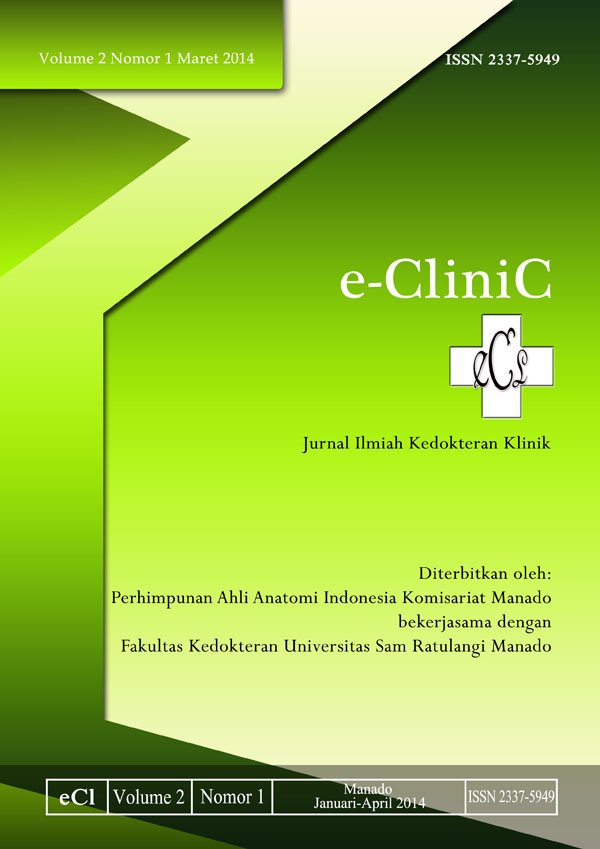POLA KUMAN BERDASARKAN PEWARNAAN GRAM PADA TINJA ANAK DENGAN DIARE DI RSUP PROF. DR. R. D. KANDOU MANADO
DOI:
https://doi.org/10.35790/ecl.v2i1.3666Abstract
Abstract: Background: Bacterial infection is one of the causes of diarrhea in infants and children. Bacteria are a group of microorganisms belongs to the prokaryotes which are structurally simpler than eukaryotics. There were many examinations used to detect the bacteria caused diarrhea, one of them was microscopic examination of the Gram stain smear. This technique is to determine whether the examination is Gram positive or Gram negative bacteria. Objective: This study aimed to determine the pattern of bacteria by Gram stain in children’s feces with diarrhea. Methods: This research used a descriptive designed with cross sectional approach by consecutive sampling from November to December 2013. There were 50 children in this study. Result: The results showed, 29 girls (58%) and 21 boys (42%). There were 34 children (68%) as the largest group that belongs to 1 - <3 years old. The results of feces microscopic examination showed 29 children (58%) got contaminated by bacteria. 23 children (46%) were contaminated with Gram positive and Gram negative bacteria. Gram negative Basil bacteria ware the most common bacteria that found in 23 preparations. Conclusion: Gram-negative bacilli germ were the most common germs that found in children’s feces with diarrhea and the numbers of diarrhea on November to December 2013 were increased.
Key words: bacterial pattern, Gram staining, children, diarrhea
Â
Abstrak: Latar belakang: Infeksi bakteri merupakan salah satu penyebab terjadinya diare pada bayi dan anak. Bakteri merupakan mikroorganisme yang termasuk dalam golongan prokariot yang strukturnya lebih sederhana dari eukariot. Banyak pemeriksaan yang dilakukan untuk mendeteksi bakteri penyebab diare, salah satunya dengan pemeriksaan mikroskopis pulasan yaitu pewarnaan Gram yang merupakan salah satu teknik pemeriksaan untuk menentukan apakah termasuk bakteri Gram positif atau bakteri Gram negatif. Tujuan penelitian: Penelitian ini bertujuan unutk mengetahui pola kuman berdasarkan pewarnaan Gram pada tinja anak dengan diare. Metode: Penelitian ini menggunakan desain penelitian deskriptif dengan pendekatan cross sectional yang dilakukan dengan cara consecutive sampling dari bulan November sampai Desember 2013. Sampel penelitian berjumlah 50 anak dan dilakukan pemeriksaan pewarnaan Gram. Hasil penelitian: Hasil penelitian didapatkan, perempuan 29 anak (58%) dan Laki-laki 21 anak (42%). Kelompok umur terbanyak 1 ─ <3 berjumlah 34 anak (64%). Hasil pemeriksaan mikroskopis feses ditemukan positif bakteri sebanyak 29 anak (58%). Bakteri Gram positif dan Gram negatif didapatkan berjumlah 23 anak (46%). Bakteri Basil Gram negatif merupakan bakteri terbanyak yang ditemukan yaitu 23 preparat. Kesimpulan: Kuman basil Gram negatif merupakan kuman terbanyak yang ditemukan pada tinja anak dengan diare dan terjadi peningkatan angka kejadian diare pada bulan November – Desember 2013.
Kata kunci : pola kuman, pewarnaan Gram , anak, diare
Downloads
How to Cite
Issue
Section
License
COPYRIGHT
Authors who publish with this journal agree to the following terms:
Authors hold their copyright and grant this journal the privilege of first publication, with the work simultaneously licensed under a Creative Commons Attribution License that permits others to impart the work with an acknowledgment of the work's origin and initial publication by this journal.
Authors can enter into separate or additional contractual arrangements for the non-exclusive distribution of the journal's published version of the work (for example, post it to an institutional repository or publish it in a book), with an acknowledgment of its underlying publication in this journal.
Authors are permitted and encouraged to post their work online (for example, in institutional repositories or on their website) as it can lead to productive exchanges, as well as earlier and greater citation of the published work (See The Effect of Open Access).







